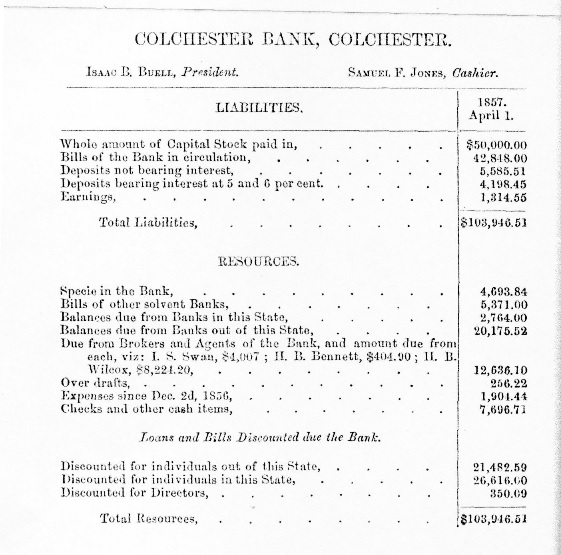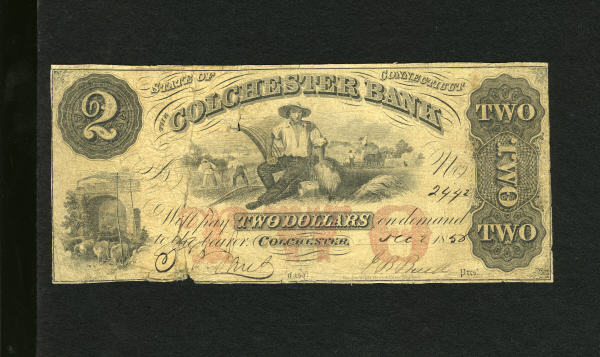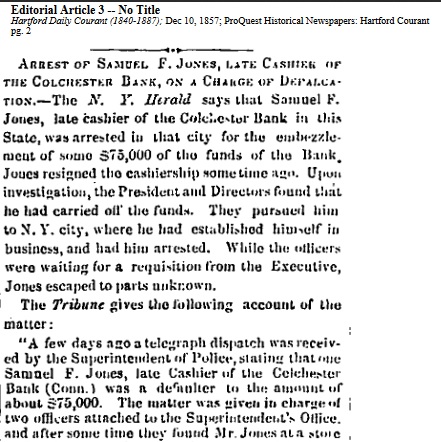Bank Scandal of the 1800s
Colchester was the center of one of the largest financial scandals of the 1800s.
Sometimes a great story gets lost over time. Print media get lost in library stacks and people pass away. This story is one of that needs to be revived.

The Bank’s Beginning:
Colchester bank started in 1856 under the leadership of Isaac B. Buell. It reflected Colchester’s importance to the local economy of Southeastern Connecticut. Its initial cashier was Samuel F. Jones. Per the May Session 1857 Bank Commissioner’s report to the Connecticut General Assembly, the bank had $103,946 in resources. This was about $2.7 million in 2016 dollars.
It’s interesting to note that the bank was no longer listed after 1857. Upon further research reading old articles from the Hartford Courant (via the website iconn.org), an interesting tale of greed and scandal unfolded.
The Crime:

In the December 10, 1857 edition of the Hartford Daily Courant, Mr. Jones was arrested for embezzling $75,000 from the bank. This was the equivalent of $2.0 million in 2016 dollars.
In the December 22, 1857 edition of the Hartford Daily Courant, Mr. Jones was also found to have illegally printed $101,000 in draft notes ($2.4 million in 2016 dollars), for his own personal use in 1857. He convinced the bank president, Isaac Buell, to sign the draft notes without knowledge the bank did not have the resources to cover the notes. It was this act that drove the final nail into the bank’s coffin. Once the financial mess was discovered, the bank was put into receivership by state banking officials. Eventually, all holders of the bank draft notes were given about 25 cents on the dollar.
The Escape, Chase, and Eventual Capture:

In the December 10, 1857 edition of the Hartford Daily Courant, Mr. Jones was arrested in New York City and confined to a hotel until local banking officials arrived. In the interim, Mr. Jones’ lawyers succeeded in getting him released. Once local banking officials arrived they found out that Mr. Jones was nowhere to be found.
In the February 16, 1859 edition of the Hartford Daily Courant, it was revealed that the New York City Police Commissioner was personally embarrassed that Mr. Jones escaped custody in 1857. In 1859, detectives got a break by locating and following Mr. Jones’ wife to his hiding place at the Metropolitan Hotel. It was rumored that Mr. Jones used his ill-gotten wealth to invest with the owner of the Metropolitan Hotel. A scuffle ensued to arrest Mr. Jones and bring him to justice in Connecticut.
The article went on to state, however, that more intrigue was involved. While under armed escort back to Connecticut, Mr. Jones’ train was stopped in Harlem. It turned out that the wrong writ was issued and the New York City officials refused to let Mr. Jones leave the city. Connecticut officials seemed to have been baffled by the legal wrangling. This eventually escalated to the governors of New York and Connecticut exchanging harsh words. It also caught the attention of national newspapers. The papers started to call it the financial scandal of the century.
In the February 21, 1857 edition of the Hartford Daily Courant, the final chapter in the Jones saga was told. Mr. Jones was placed under an armed police escort back to Connecticut. Unbeknownst to Connecticut policemen, Mr. Jones’ friends mounted a large group of armed Pinkerton detectives intending to rescue Mr. Jones. The article details the chase through Connecticut’s back roads. Eventually, Mr. Jones arrived safely to Norwich and brought to justice. This ended the saga of one of the nation’s largest banking scandals of the 1800s.
